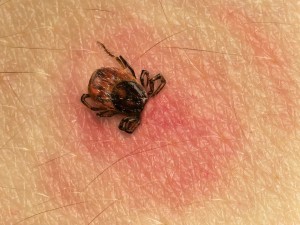 May is Lyme Disease Awareness Month. Yes, there is a month for everything it seems. As we are closing out May we thought we’d share a few key pieces of information and perspective.
May is Lyme Disease Awareness Month. Yes, there is a month for everything it seems. As we are closing out May we thought we’d share a few key pieces of information and perspective.
- Lyme disease is spread through a black legged tick, also known as a ‘deer tick’. Ticks can attach to any part of the human body, but they like those hard to see places groins/armpits/etc. Most infections come from being bitten by nymphs, baby ticks, because they are so much smaller and harder to detect than an adult tick. An adult deer tick can infect a person, but they are more easily discovered and thus less likely to cause harm. The nymphs are most active in spring and summer (they grow up after that) and that is when you see most concerns for Lyme Disease shared. There is no evidence to support the spread of Lyme Disease through other means, so your dog might become infected with Lyme Disease they cannot transfer it to you.
- If you have a tick bite, and live in a known area (East Tennessee is slowly become more of a common area for Lyme Disease), then you will experience a myriad of symptoms. The big symptom of Lyme Disease is a large ‘bulls eye target’ rash that emanates from the bite center. You may experience fatigue, fever, headache, swollen lymph nodes, and muscle and joint aches along with your rash. The rash only occurs in 70-80% of all infections, so the absence of a rash shouldn’t keep you from having a concern. The Lyme Disease rash will take about three days to start to appear. If you are bitten by a tick you need to pay attention to the bite area and your overall health. Any of these signs and you should see a physician quickly for treatment.
- Physicians might use a blood test to determine if you have Lyme Disease, but only if you have a strong showing of symptoms. It is important for doctors not to mis-diagnose you. A treatment of antibiotics in the early stages of infection are generally effective and will lead to a full recovery. 10-20% of infected patients are known to have persistent health issues associated with Lyme Disease. Most of those cases became tougher to treat because of a lag time in treatment.
- Prevention for all ticks year round is a great strategy for protecting you and your pets from deer ticks and Lyme Disease. Keeping your yard mowed will help keep ticks from getting on you, they thrive in the tall grass and bushy environments. Avoiding tall grassy areas and wooded areas if possible is a best practice. Spraying on repellent with 20-30% DEET will help to repel and kill ticks. Putting permethrin on your clothing and outdoor equipment will help to repel ticks as well. When you get in from the outdoors be sure to do a full body check and bathe thoroughly so that you may discover any possible tick hitchhikers. Check your clothing and equipment as well. Even if you wash clothes ticks have been known to survive and still find a host. Drying clothes on high heat for an hour can kill off ticks if you suspect they might be in your laundry.
- If you, or a family member, are bitten by a tick then the best way to remove them is with a fine tipped tweezers. Burning them, slathering with nail polish remover or petroleum jelly, or painting them will not give you the results you want, which is to have them off of you as quickly as possible. Take the tweezer blades and fit one on top of the tick and the other underneath the tick and skin. Do not do a side to side, gripping while working with the legs can be troublesome and ineffective. Lift the tick vertically while holding the tick as close to the heads attached point to the skin as possible. Then pull off evenly and firmly. Getting anxious at this point and jerking or squeezing might result in tearing the tick and leaving some portion of their body attached to your skin.
- After you have removed the tick you can be on the lookout for those symptoms and contact your physician as needed. East Tennessee is not the hotbed for Lyme Disease that the Northeastern portion of the United States is, but it making its presence known more and more each and every year.
So as we wrap up spring and move into early summer be aware of Lyme Disease and the deer ticks so that you can protect your family from both. If you want to know more about Lyme Disease and see some area maps of activity check out the Center for Disease Control’s webpages dedicated to the disease.
Lyme Disease Awareness in Sevierville TN
Serving Sevier County and surrounding areas since 1984